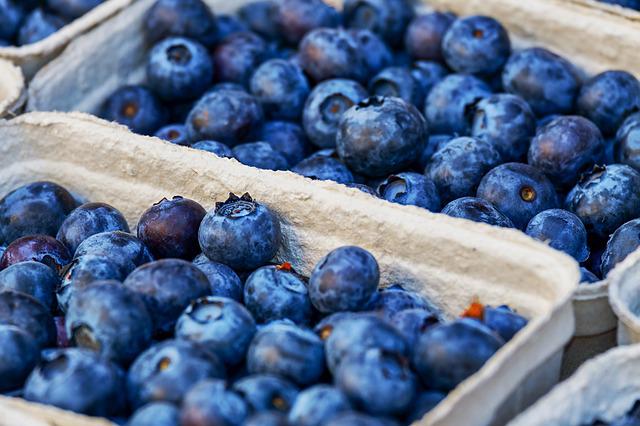Where Do Blueberries Come From?

Originating in North America, blueberries (Vaccinium) are still widely used in various dishes such as pancakes, muesli, and granola, among others. Harvesting became easier in North America after larger fruits and bushes were planted around 1909.
Blueberry bushes can grow all over the United States, and farmers in 26 states are actively involved in the commercial production of blueberries. Almost all of it is produced in just ten states that stretch from coast to coast.
Table of Contents
History and Cultivation
Blueberries have only been cultivated for about a century since the turn of the 20th century, and as such, they were not the commonplace fruit they are today. Wild-harvested berries were available in the United States but limited their distribution.
Based on the most widely accepted theories, North America’s native blueberries date back at least 15,000 years. Still, new research suggests that humans first arrived on the continent much earlier than previously thought. More than 35 species of blueberries can be found in the genus Vaccinium. Vaccinium species are found worldwide, and their genomes reflect this diversity. We have a wide range of Vaccinium species on our continent, from the warm-climate varieties in Mexico to the cold-climate varieties in Canada and Alaska. When it comes to cultivating blueberries in the Midwest, most of the varieties are derived from Vaccinium corymbosum, native to the southern United States and eastern Canada (Zones 5-8).
Native American Origins of Blueberries
In the beginning, a New Jersey cranberry farmer’s daughter was responsible for modern commercial blueberry cultivation. Elizabeth White was fascinated by the blueberry’s potential as a cultivated crop from the 1890s. Other growers didn’t believe that they could be domesticated, though There was a fundamental misunderstanding of what blueberries require to survive.
In the beginning, a New Jersey cranberry farmer’s daughter was responsible for modern commercial blueberry cultivation. Elizabeth White was fascinated by the blueberry’s potential as a cultivated crop from the 1890s. Other growers didn’t believe that they could be domesticated, though There was a fundamental misunderstanding of what blueberries require to survive.
USDA botanist Frank Coville began studying North American blueberry species in the early 1900s to create improved cultivars for commercial production.
He had already made history in the world of U.S. botany in the early 1890s when he was a field botanist on the first comprehensive, multidisciplinary expedition to Death Valley. Before becoming the USDA’s chief botanist, he had written more than 170 scientific papers and books.
At the beginning of the 20th century, Coville wrote a book called “Experiments in Blueberry Culture.” He describes his research and that of other people who worked on growing Vaccinium species in the United States. Coville made an important discovery: Blueberries need very acidic soil, which had never been thought of before.
There, on her cranberry farm in New Jersey, Elizabeth White read Colville’s book from 1911 and called him right away. She agreed to let Coville use a lot of land on her farm for research and development. This helped lay the groundwork for our modern blueberry varieties.
Blueberry Boom
During the 1990s and early 2000s, a large body of scientific research examined the health benefits of blueberries, deeming them a “superfood.” Blueberry production has risen from around 100 million pounds per year in the late 1990s to more than 500 million pounds recently due to this discovery.
You should remember the fascinating history of these little blue superfoods on our continent the next time you eat them and express your gratitude to indigenous people and later horticulturists who pioneered their development. Without them, they wouldn’t be found on the shelves of our supermarkets.
In North America, blueberries come from the same place. Explorers took note of wild blueberries while they were out on their trips. Blueberries were being harvested by Native Americans near Lake Huron in 1615 when Samuel de Champlain went to see them.
It was 1936 when blueberries were first grown in North Carolina. The blueberries were grown by a businessman from New Jersey who lived in the state. There wasn’t enough time to grow blueberries in New Jersey, so he decided not to do that. So he started looking for a place where he could plant blueberries that would be ready at a different time to have more blueberries for a longer time.
All of Harold Huntington’s blueberries came from New Jersey and were taken to his farm in Cooperstown, NC, in between Atkinson, NC, and Ivanhoe, NC was Mr. Huntington’s farm of 1,000 acres, which was between these two cities: The second piece of land was bought by Gale Harrison from New Jersey, who lives in New York. Along with local farmers, these newcomers started to set up berries. Soon, a business was born. There was a New Jersey distribution company that they worked with. The Atkinson crop was shipped to New Jersey by train.
From Bush To Bushel
Blueberry plants, which are related to cranberries, are established from seeds. Once fully grown, additional roots penetrate the soil and grow into new blueberry bushes nearby. Each new bush that sprouts from the original’s roots are genetically distinct from the others. Wild blueberries grow on 4- to 15-inch-tall bushes, whereas commercial blueberries grow on 6-foot-tall highbush plants.
Chill hours refer to the number of hours spent by blueberry plants in temperatures below 45 degrees. These chill hours are critical for the blueberry plant because they enable it to remain dormant until the spring, ready to produce new foliage and fruit. The chill hours vary according to the variety and the region in which it is grown. For instance, blueberries grown in the southern United States require between 0 and 250 chill hours, whereas blueberries grown in New England may require between 900 and 1200 chill hours.
